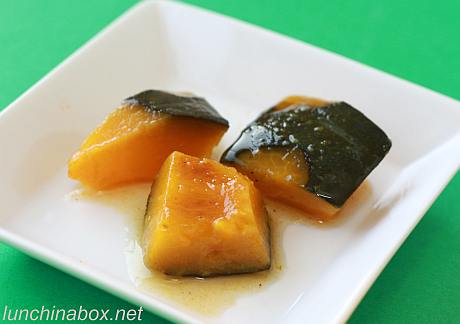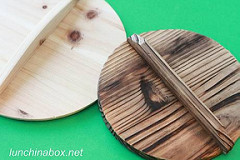Simmered kabocha recipe


Simmered kabocha squash is a favorite of mine — it’s one of the most flavorful squashes around, and is chock full of nutrients like beta carotene (especially when you eat the thin skin). Simmered kabocha is a staple in Japanese bento lunches, evoking strong memories for me of train station bentos and home cooking I ate in Japan. Simple to make, you can also transform any leftovers by mashing the cooked kabocha with a fork and making it into squash croquettes, substituting mashed squash for the mashed potatoes. Try it!
Simmered Kabocha
Some recipes call for cutting the kabocha into chunks first and then painstakingly peeling a bit of the skin off of each chunk to aid cooking. That’s WAY too time-consuming and fiddly for me, so before I cube it I use a vegetable peeler to take random pieces of skin off of the whole kabocha first.
- 1 small kabocha squash, about 2 pounds
- 1.5 cups dashi (bonito fish broth, or you can use hon dashi instant granules for convenience)
- 2 Tb mirin
(sweetened cooking sake, or use regular sake and increase the sugar slightly. You can omit this entirely, but then increase the sugar to 2 Tb)
- 1 Tb sugar
- 1 tsp soy sauce
- Thoroughly wash and rinse the kabocha before cutting, using a vegetable brush to remove any dirt.
 Cut the kabocha in half and remove the seeds and stringy insides (I use an ice cream scoop for this, but a spoon works well too). Cut into quarters, and use a vegetable peeler or a sharp knife to take off little bits of skin from random places all over the kabocha. This will help it cook evenly and flavor the inside of the squash. Cut the kabocha into 1.5-inch chunks.
Cut the kabocha in half and remove the seeds and stringy insides (I use an ice cream scoop for this, but a spoon works well too). Cut into quarters, and use a vegetable peeler or a sharp knife to take off little bits of skin from random places all over the kabocha. This will help it cook evenly and flavor the inside of the squash. Cut the kabocha into 1.5-inch chunks.- Put the kabocha chunks skin side down in a single layer in a saute pan or deep frying pan.
- Mix together the dashi, mirin, sugar, and soy sauce, and pour into the pan with the kabocha.
- Cover with a drop lid or drop lid substitute (see note below)
- Bring to a boil over high heat, turn the heat down to medium low. Simmer kabocha until almost tender, about 20 minutes.
- Remove from heat and let it cool in the remaining liquid for 15 minutes to develop the flavor. Serve warm or at room temp.
 Equipment Note: My Oxo Good Grips vegetable peeler
Equipment Note: My Oxo Good Grips vegetable peeler is killer at hard squash — a strong recommend if you’re in the market for a new one. (I’m not affiliated with Oxo, BTW.)
Freezing Tip: You can freeze the cooked kabocha for speed bentos. Drain and freeze in individual portions, or go the IQF (individual quick freeze) route for maximum flexibility. After draining, spread the chunks out on a metal baking sheet or pan and freeze. Once frozen, transfer to a freezer bag so that you can pull out a few chunks at a time.
* * * * *


A drop lid, or otoshi-buta, is a lightweight wooden lid that fits down inside of a pan and floats on the surface of simmering food. I picked these up at Daiso (Japanese discount store with branches internationally) for US$1.50 each, but for this recipe you could also just fashion a quick substitute out of a round of parchment paper or use a regular lid that’s too small for the pan you’re using.
FURTHER READING:
- “Leftover Remake” posts: turning leftovers into something different
- All recipes on Lunch in a Box





